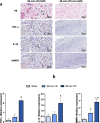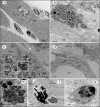Reperfused hemorrhagic myocardial infarction in rats
- PMID: 33264359
- PMCID: PMC7710030
- DOI: 10.1371/journal.pone.0243207
Reperfused hemorrhagic myocardial infarction in rats
Abstract
Background: Intramyocardial hemorrhage following reperfusion is strongly associated with major adverse cardiovascular events in myocardial infarction (MI) patients; yet the mechanisms contributing to these outcomes are not well understood. Large animal models have been used to investigate intramyocardial hemorrhage, but they are exorbitantly expensive and difficult to use for mechanistic studies. In contrast, rat models are widely used to investigate mechanistic aspects of cardiovascular physiology, but a rat model that consistently recapitulates the characteristics of an hemorrhagic MI does not exist. To bridge this gap, we investigated the physiological conditions of MI that would create intramyocardial hemorrhage in rats so that a reliable model of hemorrhagic MI would become available for basic research.
Methods & results: Sprague-Dawley rats underwent either a 90-minute (90-min) ischemia and then reperfusion (I/R) (n = 22) or 30-minute (30-min) I/R (n = 18) of the left anterior descending coronary artery. Sham rats (n = 12) were used as controls. 90-min I/R consistently yielded hemorrhagic MI, while 30-min I/R consistently yielded non-hemorrhagic MI. Twenty-four hours post-reperfusion, ex-vivo late-gadolinium-enhancement (LGE) and T2* cardiac MRI performed on excised hearts from 90-min I/R rats revealed colocalization of iron deposits within the scarred tissue; however, in 30-min I/R rats scar was evident on LGE but no evidence of iron was found on T2* CMR. Histological studies verified tissue damage (H&E) detected on LGE and the presence of iron (Perl's stain) observed on T2*-CMR. At week 4 post-reperfusion, gene and protein expression of proinflammatory markers (TNF-α, IL-1β and MMP-9) were increased in the 90-min I/R group when compared to 30-min I/R groups. Further, transmission electron microscopy performed on 90-min I/R myocardium that were positive for iron on T2* CMR and Perl's stain showed accumulation of granular iron particles within the phagosomes.
Conclusion: Ischemic time prior to reperfusion is a critical factor in determining whether a MI is hemorrhagic or non-hemorrhagic in rats. Specifically, a period of 90-min of ischemia prior to reperfusion can produce rat models of hemorrhagic MI, while 30-minutes of ischemia prior to reperfusion can ensure that the MIs are non-hemorrhagic. Hemorrhagic MIs in rats result in marked increase in iron deposition, proinflammatory burden and adverse left-ventricular remodeling compared to rats with non-hemorrhagic MIs.
Conflict of interest statement
The authors have declared that no competing interests exist.
Figures




Similar articles
-
Influence of Myocardial Hemorrhage on Staging of Reperfused Myocardial Infarctions With T2 Cardiac Magnetic Resonance Imaging: Insights Into the Dependence on Infarction Type With Ex Vivo Validation.JACC Cardiovasc Imaging. 2019 Apr;12(4):693-703. doi: 10.1016/j.jcmg.2018.01.018. Epub 2018 Apr 18. JACC Cardiovasc Imaging. 2019. PMID: 29680356 Free PMC article.
-
Chronic manifestation of postreperfusion intramyocardial hemorrhage as regional iron deposition: a cardiovascular magnetic resonance study with ex vivo validation.Circ Cardiovasc Imaging. 2013 Mar 1;6(2):218-28. doi: 10.1161/CIRCIMAGING.112.000133. Epub 2013 Feb 12. Circ Cardiovasc Imaging. 2013. PMID: 23403335
-
Intramyocardial Hemorrhage and the "Wave Front" of Reperfusion Injury Compromising Myocardial Salvage.J Am Coll Cardiol. 2022 Jan 4;79(1):35-48. doi: 10.1016/j.jacc.2021.10.034. J Am Coll Cardiol. 2022. PMID: 34991787
-
Human Recombinant Apyrase Therapy Protects Against Myocardial Ischemia/Reperfusion Injury and Preserves Left Ventricular Systolic Function in Rats, as Evaluated by 7T Cardiovascular Magnetic Resonance Imaging.Korean J Radiol. 2020 Jun;21(6):647-659. doi: 10.3348/kjr.2019.0853. Korean J Radiol. 2020. PMID: 32410404 Free PMC article.
-
T2 mapping at 7T MRI can quantitatively assess intramyocardial hemorrhage in rats with acute reperfused myocardial infarction in vivo.J Magn Reson Imaging. 2016 Jul;44(1):194-203. doi: 10.1002/jmri.25145. Epub 2016 Jan 13. J Magn Reson Imaging. 2016. PMID: 26762612
Cited by
-
Myocardial infarction size as an independent predictor of intramyocardial haemorrhage in acute reperfused myocardial ischaemic rats.Eur J Med Res. 2022 Oct 28;27(1):220. doi: 10.1186/s40001-022-00834-5. Eur J Med Res. 2022. PMID: 36307869 Free PMC article.
-
Imatinib attenuates reperfusion injury in a rat model of acute myocardial infarction.Basic Res Cardiol. 2023 Jan 13;118(1):2. doi: 10.1007/s00395-022-00974-z. Basic Res Cardiol. 2023. PMID: 36639597 Free PMC article.
References
-
- Ir Degano, Subirana I, Fusco D, Tavazzi L, Kirchberger I, Farmakis D, et al. Percutaneous Coronary Intervention Reduces Mortality In Myocardial Infarction Patients With Comorbidities: Implications For Elderly Patients With Diabetes Or Kidney Disease. Int J Cardiol. 2017;249:83–9. 10.1016/j.ijcard.2017.07.054 - DOI - PubMed
Publication types
MeSH terms
Substances
Grants and funding
LinkOut - more resources
Full Text Sources
Other Literature Sources
Medical
Miscellaneous

